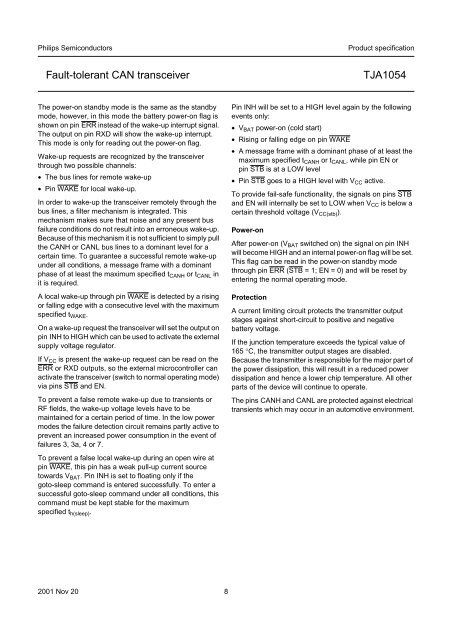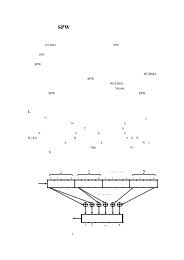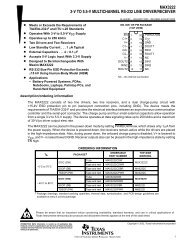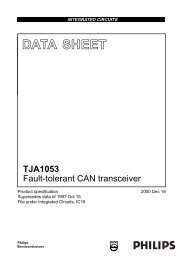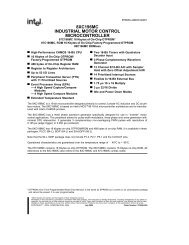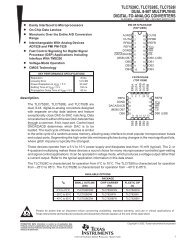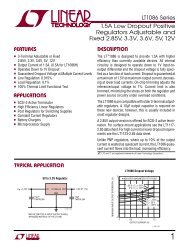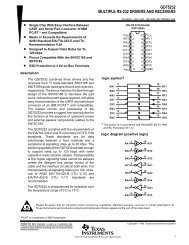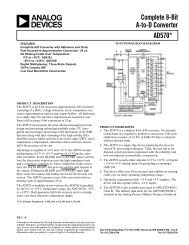TJA1054 Fault-tolerant CAN transceiver
TJA1054 Fault-tolerant CAN transceiver
TJA1054 Fault-tolerant CAN transceiver
You also want an ePaper? Increase the reach of your titles
YUMPU automatically turns print PDFs into web optimized ePapers that Google loves.
Philips SemiconductorsProduct specification<strong>Fault</strong>-<strong>tolerant</strong> <strong>CAN</strong> <strong>transceiver</strong><strong>TJA1054</strong>The power-on standby mode is the same as the standbymode, however, in this mode the battery power-on flag isshown on pin ERR instead of the wake-up interrupt signal.The output on pin RXD will show the wake-up interrupt.This mode is only for reading out the power-on flag.Wake-up requests are recognized by the <strong>transceiver</strong>through two possible channels:• The bus lines for remote wake-up• Pin WAKE for local wake-up.In order to wake-up the <strong>transceiver</strong> remotely through thebus lines, a filter mechanism is integrated. Thismechanism makes sure that noise and any present busfailure conditions do not result into an erroneous wake-up.Because of this mechanism it is not sufficient to simply pullthe <strong>CAN</strong>H or <strong>CAN</strong>L bus lines to a dominant level for acertain time. To guarantee a successful remote wake-upunder all conditions, a message frame with a dominantphase of at least the maximum specified t <strong>CAN</strong>H or t <strong>CAN</strong>L init is required.A local wake-up through pin WAKE is detected by a risingor falling edge with a consecutive level with the maximumspecified t WAKE .On a wake-up request the <strong>transceiver</strong> will set the output onpin INH to HIGH which can be used to activate the externalsupply voltage regulator.If V CC is present the wake-up request can be read on theERR or RXD outputs, so the external microcontroller canactivate the <strong>transceiver</strong> (switch to normal operating mode)via pins STB and EN.To prevent a false remote wake-up due to transients orRF fields, the wake-up voltage levels have to bemaintained for a certain period of time. In the low powermodes the failure detection circuit remains partly active toprevent an increased power consumption in the event offailures 3, 3a, 4 or 7.To prevent a false local wake-up during an open wire atpin WAKE, this pin has a weak pull-up current sourcetowards V BAT . Pin INH is set to floating only if thegoto-sleep command is entered successfully. To enter asuccessful goto-sleep command under all conditions, thiscommand must be kept stable for the maximumspecified t h(sleep) .Pin INH will be set to a HIGH level again by the followingevents only:• V BAT power-on (cold start)• Rising or falling edge on pin WAKE• A message frame with a dominant phase of at least themaximum specified t <strong>CAN</strong>H or t <strong>CAN</strong>L , while pin EN orpin STB is at a LOW level• Pin STB goes to a HIGH level with V CC active.To provide fail-safe functionality, the signals on pins STBand EN will internally be set to LOW when V CC is below acertain threshold voltage (V CC(stb) ).Power-onAfter power-on (V BAT switched on) the signal on pin INHwill become HIGH and an internal power-on flag will be set.This flag can be read in the power-on standby modethrough pin ERR (STB = 1; EN = 0) and will be reset byentering the normal operating mode.ProtectionA current limiting circuit protects the transmitter outputstages against short-circuit to positive and negativebattery voltage.If the junction temperature exceeds the typical value of165 °C, the transmitter output stages are disabled.Because the transmitter is responsible for the major part ofthe power dissipation, this will result in a reduced powerdissipation and hence a lower chip temperature. All otherparts of the device will continue to operate.The pins <strong>CAN</strong>H and <strong>CAN</strong>L are protected against electricaltransients which may occur in an automotive environment.2001 Nov 20 8


